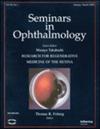电灯开关和调光器:改进诊断性泪腺灌注的定性观察。
IF 1.9
4区 医学
Q2 OPHTHALMOLOGY
引用次数: 0
摘要
目的强调泪道冲洗过程中的 "软 "观察对诊断泪道流出功能障碍和报告 DCR 术后软因素结果的重要性。对生理盐水回流百分比 (RFX)、初始回流粘液 (IMR)、患者报告的生理盐水转运时间 (PR-TTS) 和 LS 期间遇到的阻力 (RES) 进行了比较分析。采用经过验证的 TEARS 评分。主观成功定义为 TEARS 评分的 T 子量表改善≥ 2 分。客观成功是指术后 RFX、RES、PR-TTS 下降和无 IMR。结果在接受 DCR 手术的 253 名患者中,有 8 名患者符合纳入标准。所有患者在室内外均为 T4(每天擦拭次数大于 10 次)。手术后,TEARS 评分有所改善,T=2.62、E=1.63 和 A=1.35(p < .05),R 评分无明显变化(p = .10)。RFX的平均降幅为11.75 ± 6.74%,PR-TTS和RES的中位数分别提高了1分和2分(p < .05)。在此期间,对侧的这些参数没有发生明显变化。结论本研究首次尝试结合泪道冲洗过程中的定性 "软 "观察指标,如 IMR、RES 和 PR-TTS,来识别鼻泪管外流功能障碍,并使用这些参数报告外溢和≤ 20% 液体反流患者的 DCR 结果。这些参数在症状较重的一侧更大,并在 DCR 后成功改善,使其成为达成临时诊断的重要工具。本文章由计算机程序翻译,如有差异,请以英文原文为准。
The Light Switch and the Dimmer: Qualitative Observations to Improve Diagnostic Lacrimal Irrigation.
PURPOSE
To emphasise the importance of "soft" observations during lacrimal irrigation in diagnosing lacrimal outflow dysfunction and reporting outcomes of soft factors post-DCR.
METHODS
A retrospective study of patients with ≤ 20% of regurgitation on lacrimal irrigation who underwent DCR surgery. A comparative analysis of percentage reflux of saline (RFX), initial mucus in reflux (IMR), patient-reported transit time of saline (PR-TTS), and resistance encountered (RES) during LS was performed. Validated TEARS score was used. Subjective success was defined as ≥ 2-point improvement in T subscale of TEARS score. Objective success, as a decrease in RFX, RES, PR-TTS and absence of IMR, post-operatively.
RESULTS
From a total of 253 patients who underwent DCR surgery, 8 patients met the inclusion criteria. All patients were T4 (wiping >10× daily) indoors and outdoors. TEARS score improved after surgery with a mean reduction of T = 2.62, E = 1.63 and A = 1.35 (p < .05) with no significant change in R scores (p = .10). A mean reduction in RFX of 11.75 ± 6.74% and a median improvement of 1 point in PR-TTS and 2 point in RES was observed (p < .05). No significant changes of these parameters occurred in the contralateral side during this period. Subjective and objective success of DCR was 75% and 100%, respectively.
CONCLUSIONS
This study is the first to attempt to combine qualitative "soft" observations during lacrimal irrigation such as IMR, RES and PR-TTS for identifying nasolacrimal outflow dysfunction and reporting outcomes using these parameters of DCR in patients with epiphora and ≤ 20% of fluid regurgitation. These parameters were greater in the more symptomatic side and successfully improved after DCR, making them a valuable tool to reach a provisional diagnosis.
求助全文
通过发布文献求助,成功后即可免费获取论文全文。
去求助
来源期刊

Seminars in Ophthalmology
OPHTHALMOLOGY-
CiteScore
3.20
自引率
0.00%
发文量
80
审稿时长
>12 weeks
期刊介绍:
Seminars in Ophthalmology offers current, clinically oriented reviews on the diagnosis and treatment of ophthalmic disorders. Each issue focuses on a single topic, with a primary emphasis on appropriate surgical techniques.
 求助内容:
求助内容: 应助结果提醒方式:
应助结果提醒方式:


